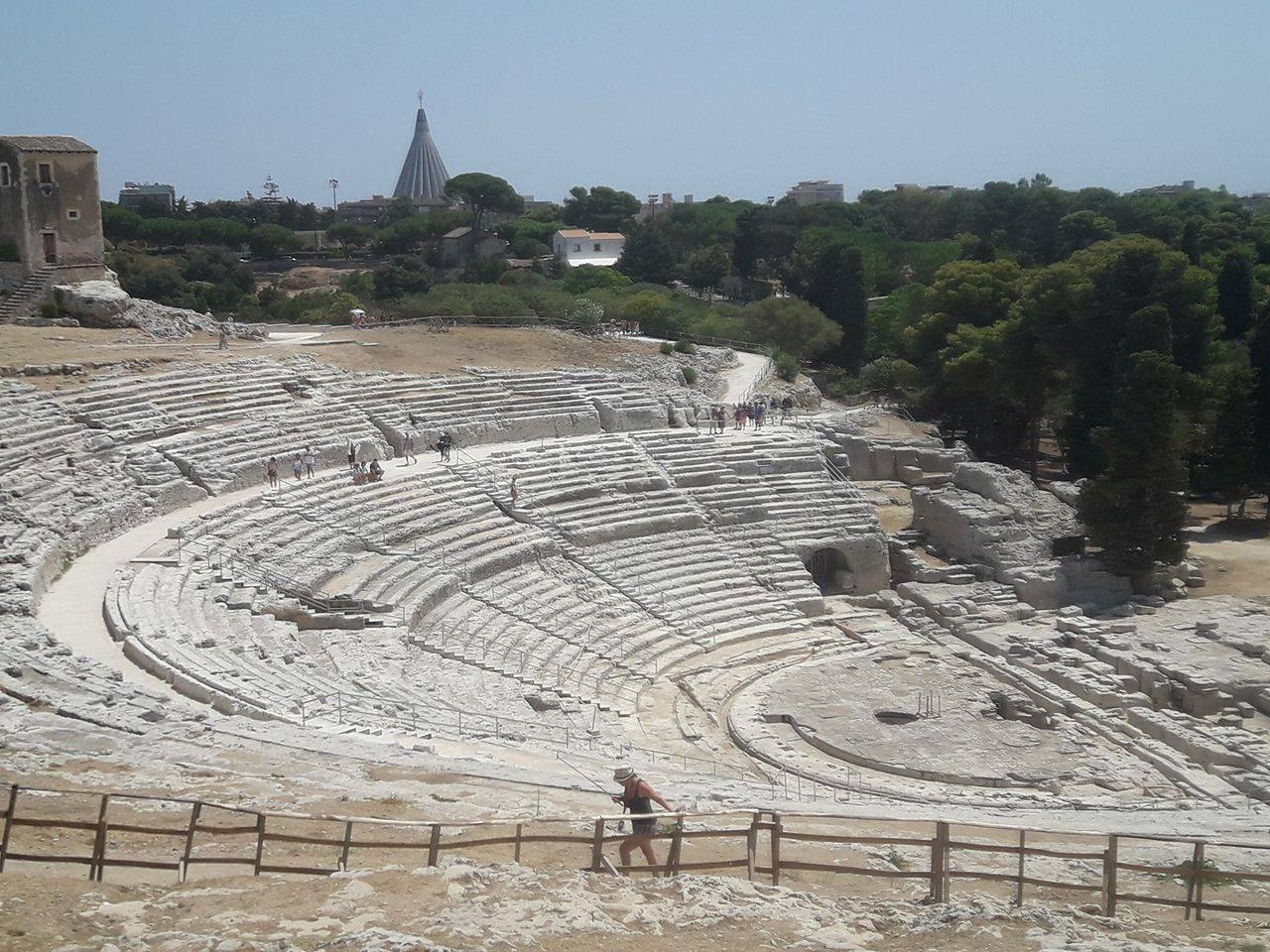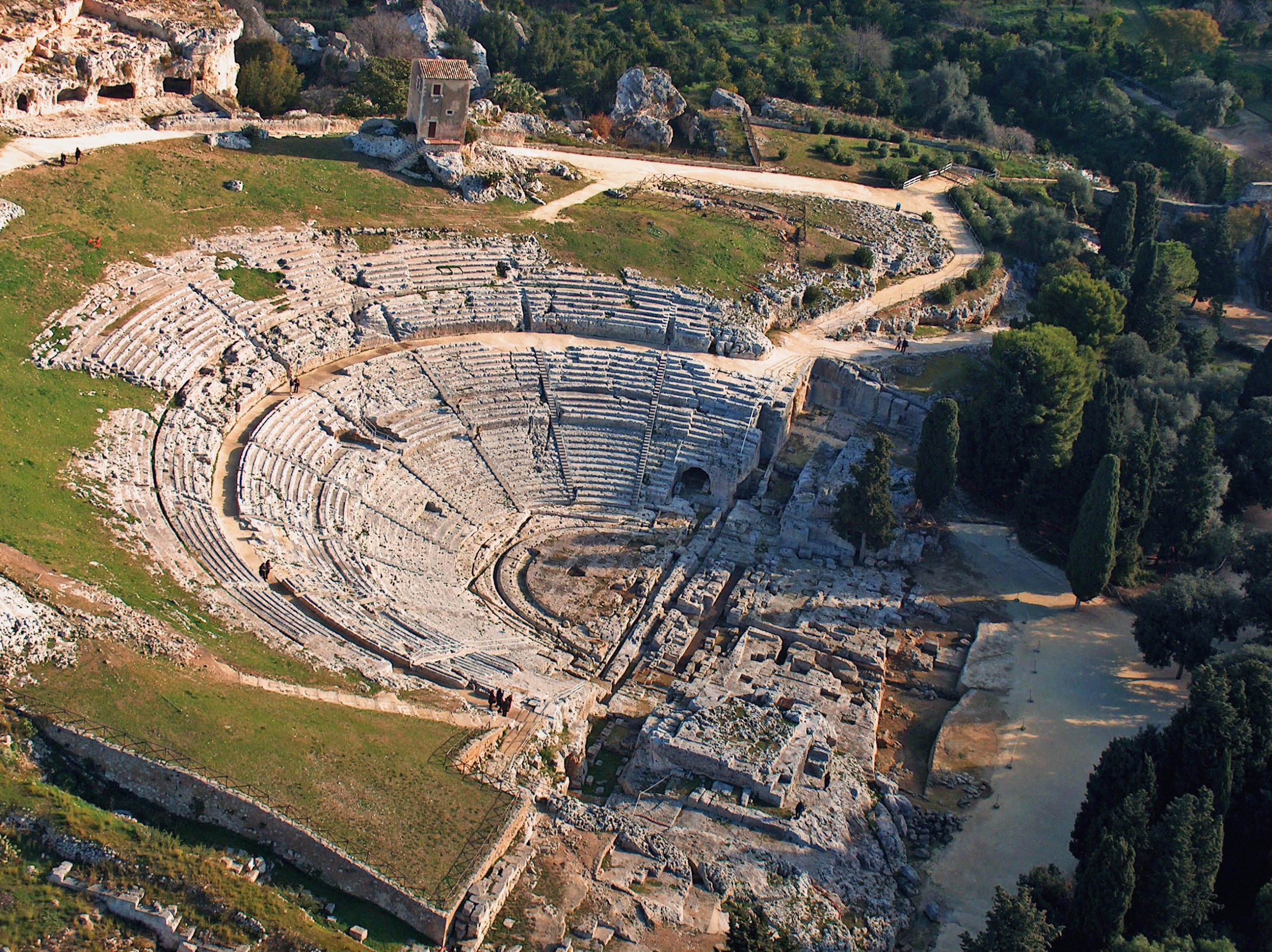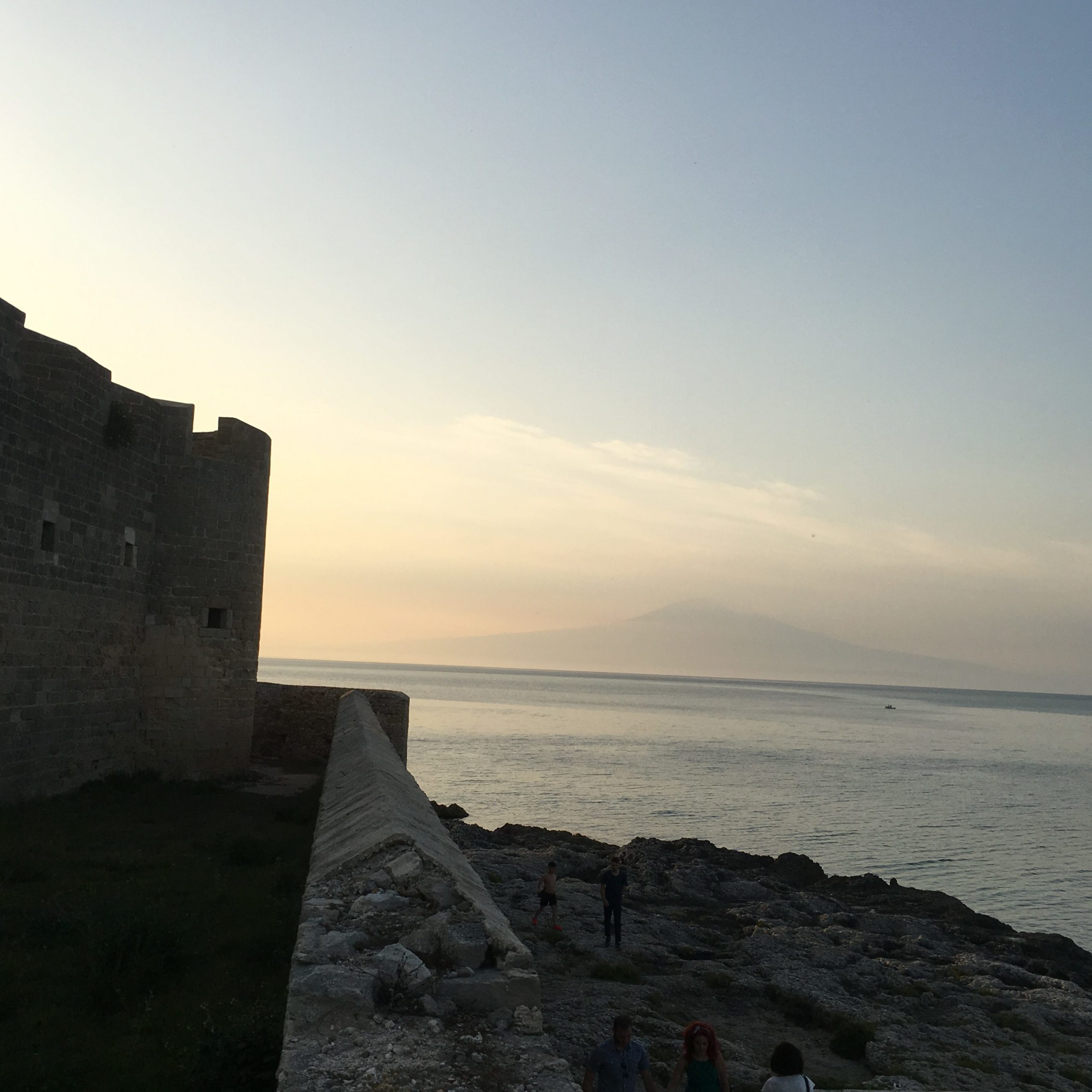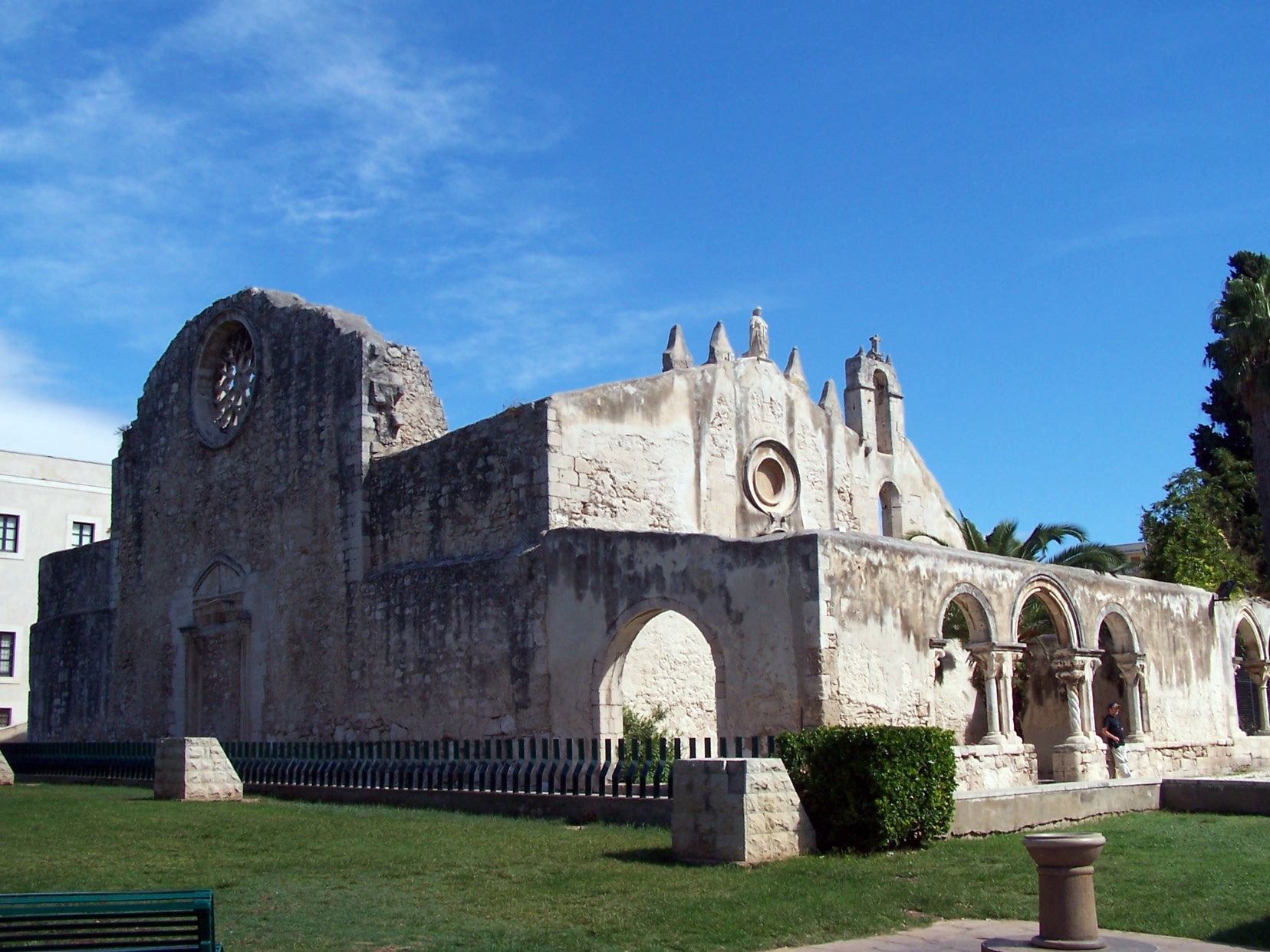The Greek Theatre
Located in the Neapolis Archaeological Park, the Greek Theatre is entirely carved into the natural rock of the slope of the Colle Temenite, on which the entire Archaeological Park is based, and is the greatest evidence of Greek architecture between the 5th and 3rd centuries BC.
It is reported that there has been a theatre in Siracusa
since the first half of the 5th century BC.
The mimographer and writer Sofrone tells us that Hieron I, (tyrant of Gela from 484 B.C. to 478 B.C. and later tyrant of Syracuse until his death) commissioned in 474 B.C. the work to the architect Demoskopos, who was nicknamed Myrilla because at the inauguration of the Teatro poured some ointments (from Myroi, ointment).
Diodorus Siculus, Sicilian historian, (Siceliots were the inhabitants of the Greek poleis of Sicily) reports the arrival in Syracuse of Dionysius (tyrant of Syracuse, military and tragedian) in 406 BC.
Plutarch (biographer, writer, philosopher and ancient Greek priest, who lived under the Roman Empire) in one of his books tells of the incursion of an angry bull in the theater during a city assembly (355 BC).
Plutarch also writes of the arrival in 336 BC at the theater, in chariot of Timoleon (political and military Siceliot) while the people were gathered there, testifying to the importance of the building in public life.
Despite the many testimonies, it is still difficult to establish its date of foundation.
The Greek Theatre is one of the largest in the Greek world and the largest in Sicily. This theatre has a semicircular shape, with its 138.60 meters wide and a gently gradual difference in level of 19.10 meters between the orchestra and the highest step.
The excavations of the cavea or “koilon” began at the end of the 18th century, continued between 1804 and 1807, then resumed between 1834 and 1839 and then interrupted for almost 100 years. In 1921 they were finally resumed and completed only in the mid-twentieth century, between 1950 and 1954.
Despite the different opinions of scholars on the origins of the monument, it has generally been accepted that its current form would date back to the restructuring work of the years 238 – 215 BC under the reign of Hieron II (tyrant of Syracuse from 270 to 215 BC) who, in fact, had it built in 238 BC and that maintains the same structure until today.

It can house 15,000 people, originally had 67 orders of steps, 21 of which were large square-shaped boulders that were removed in the sixteenth century by the Spaniards on behalf of Charles V (Emperor I King of Spain, IV King of Naples and the last “real ruler” of the Holy Roman Empire) for the fortifications of Ortigia (Syracuse area) and the remaining 46 are carved directly into the rock.
By means of 8 steps, the theatre is divided into 9 sectors of 19 degrees each.
Near the central part there is a corridor called “Diazoma”, along the parapet are legible some names engraved in the rock:
ΒΑΣΙΛΕΟΣ ΙΗΡΩΝΩΣ (Basileos Ieronos) King Hieron II°
ΒΑΣΙΛΙΣΣΑΣ ΝΗΡΗΙΔΟΣ (Basilissas Nereidos) Princess Nereid, his daughter-in-law
ΒΑΣΙΛΙΣΣΑΕ ΦΙΛΙΣΤΙΔΩΣ (Basilissas Filistidos) Queen Philistid, his wife
ΔΙΟΣ ΟΛΥΜΠΙΩΥ (Dios Olimpiou) Olympic Jupiter.
At the end of the staircase, in the lowest level of the Greek Theatre, there is the semicircular orchestra that was intended to house the choir that at that time had the task of describing what was happening at that time because often could not be represented on the scene (part located in the area behind the orchestra).
The renovation of Hieron II also included the construction of a canopy, which included the Nymphaeum (Waterfall spring) which had the function of protecting the audience from heat and rain.
The Greek Theatre of Syracuse was, therefore, one of the major centres of theatrical, political and spectacular life of the time.
Several literary sources mention theatrical performances, within its history, one of which, probably the first ever was “The Persians” of Aeschylus (ancient Greek playwright) already performed in Athens in 472 BC.
At the end of the 5th century, in 470 B.C., Aeschylus also represented “Le Etnee” (a tragedy written to celebrate the re-founding of Catania and of a centre called “Aitna” where the people of Catania had found refuge after the destruction of the “Katane” colonnade by Hieron I).
The works of Dionysius I, (tyrant of Syracuse, military and tragedian) were certainly represented, but also probably the works of the guests at his court, including Carcino the Younger (Athenian poet) and Antiphon (Greek philosopher).
In Roman times, the structure of the theater had to be adapted to the new type of shows, namely fights between gladiators and beasts, was demolished the seventeenth step, to accommodate in the central part of a grandstand of honor for the aristocracy.
Even the front of the scene was rebuilt according to the lofty monumentality of Roman times, so at the top of the scene, a large arcade was erected (porticus post scaenam) which was adorned with statues and of which today we see no rest.
So the scene absorbed the orchestra and in the fourth century AD it was necessary to expand it to the maximum to use it as an arena, in order to adapt the theater to the circus ludi.
The stage was restricted by moving its forehead backwards.
It was thus enlarged by 2.55 meters, digging holes and trenches, this to allow the mobility of the scenes and to create some water shows, thus transforming the orchestra into an arena of 29.10 meters that was obtained by reducing the depth of the twelve lower steps of the cavea and eliminating the raised part intended for seats and a band behind that was designed for spectators to rest their feet.
However, there is still a trace of the original limit of the Greek “koilon”.
An iron gate was erected in this extension strip to protect the spectators during the shows in which the beasts took part.
In the part above the Greek Theatre, there is a road carved into the rock known as the “Via delle Tombe”, in fact, became a cemetery area and we know this thanks to the presence of small square niches dating back to the Byzantine era (ancient Greek city of Byzantium, renamed Constantinople in 330 AD).
In the dark years of the Middle Ages (period from the 5th to the 15th century AD) the entire Archaeological Park was part of an agricultural complex.
In the 17th century Don Pietro Gaetani, the Marquis of Sortino and Prince of Cassaro (villages in the province of Syracuse) owned 8 mills located in the area above the Greek Theatre, he reactivated at his own expense the ancient Galermi (aqueduct of Syracuse built by Gelone who was the first tyrant of Syracuse).
Today of the 8 mills only one remains, built on the rock.
In order to take full advantage of it, the present streets were dug, on which the damage caused by the wheels of the wagons, which used to load and unload the mills, can still be seen today.
Between the end of the 3rd century and the 4th century, when the Amphitheatre was created for the circus ludi, the Greek Theatre was once again used mainly for theatre performances.
The orchestra then had a floor of polychrome marble slabs, of which there is still the concrete foundation that partially preserves the design.
Even today, after more than 100 years, continue the theatrical performances that every year, give life to what were the performances of the ancient drama of those times.
In 1913 the INDA, the National Institute of Ancient Drama, was founded by Count Mario Tommaso Gargallo (Self-taught, traveller, eclectic scholar, a lover of sculpture and then of letters).
After the meeting between aristocrats and wealthy wanted by the nobleman of Syracuse Gargallo, thus gives rise to a bet that on April 16, 1914, after 2,400 years from the Polis, which would be able to bring back the classic shows at the Greek Theatre of Syracuse.
Since then, this majestic theatre has seen the greatest artists on the national and international scene perform from May to July in front of thousands of spectators. One of the most interesting and important experiences to participate for those who visit the city of Syracuse.
Agamemnon of Aeschylus was the first opera staged with the artistic direction, translation and music by Ettore Romagnoli, scenes by Duilio Cambellotti and costumes by Bruno Puozzo.
If the work of Aeschylus was the first step, the road designed by INDA has winded through mythical figures such as Medea, Oedipus and Antigone and has seen, since 1927, also the debut of the comedy with Clouds of Aristophanes.
OPENING HOURS AND PRICES
Location: Viale Paradiso – Parco Archeologico della Neapolis
Contacts.: +39 0931 489511
Archaeological site without architectural barriers
First Sunday of each month free entry.
Entry ticket to the Archaeological Park: Adults € 10.00 – Reduced € 5.00 (under 18) – Free entrance up to the age of 12.
Combined ticket for the Archaeological Park + a museum of your choice between the Paolo Orsi Museum or the Palazzo Bellomo Gallery – Ticket price: € 13.50 – Reduced € 7.00 (under 18) – Free admission until the age of 12
Opening hours of the ticket office: from 8.30 p.m. to 6.00 p.m.
PARKING OPENING HOURS: from 8.30 a.m. to 6.30 p.m.
From May 10 to July 18 the hours may vary, on the occasion of the tragedie greche that will be performed at the Greek theater.



